Amylase Serum and Acute Pancreatitis Diagnosis
Amylase Serum
What sample is needed for an Amylase Serum?
- This test is done in the patient’s serum.
- The serum is stable at room temperature for 7 days and at 4 °C for one month.
- How to get good serum?
- Take 3 to 5 ml of blood in a disposable syringe or vacutainer. Keep the syringe for 15 to 30 minutes and then centrifuge for 2 to 4 minutes. This will yield a clear serum.
What are the precautions for Amylase Serum?
- Avoid alcohol intake before sampling because it gives rise to an increase in the amylase level.
- Urine can be collected at 2 hours or 24 hours sample. Refrigerate the urine.
- Avoid contamination with saliva.
- Lipemia interferes with the reading of the result.
- Anticoagulant EDTA, fluoride, oxalate, and citrate decreased amylase levels. These anticoagulants bind the calcium ions.
What are the Indications for Amylase Serum?
- Diagnosing acute pancreatitis and monitoring the treatment are also important.
- To differentiate other abdominal pain, epigastric discomfort, nausea, and vomiting.
- In the case of ascites, it may be done to rule out pancreatitis.
How will you classify amylase?
- Serum Amylase primarily consists of salivary gland (S-type) and pancreas (p-type) isoenzymes.
- Amylase exists in two isoenzyme forms:
- P – amylase is 40% of the total and is found in the pancreas.
- S – amylase is 60% of the total and is found in the salivary glands, ovary, fallopian tubes, bronchial epithelium, testes, and intestine.
- α-Amylase is found in humans.
- β-Amylase is found in bacteria and plants.
- Both types may increase in renal insufficiency.
How does Amylase synthesis take place?
- Amylase is the smallest enzyme, with a molecular weight of 50,000 to 55,000.
- Because of its small size, it is filtered through the glomeruli and appears in the urine.
- This enzyme is synthesized in the pancreas and salivary glands. Amylase is secreted into the gastrointestinal tract, which helps digest starch and glycogen in the mouth, stomach, and intestine.
- Serum amylase consists of:
- Salivary gland amylase is S-type.
- Pancreatic amylase is P-type.
- Serum amylase consists of:
- Amylase is normally secreted from the pancreatic acinar cells into the pancreatic duct and delivered to the duodenum.
- Once in the intestine, it helps catabolize carbohydrates and starch to simple sugars.
- Amylase activity is low in infants’ blood for the first two months of life and reaches the adult level by one year.
- Amylase high activity is seen in the Pancreas and parotid gland.
- Once pancreatic acinar cells are damaged, amylase outpours into the peritoneum and is absorbed by the blood and lymph.
What is the clinical significance of Amylase Serum?
- Amylase activity in the blood is low and constant, increasing in acute pancreatitis and salivary gland inflammations.
- Its main clinical significance is in the following:
- P-amylase is raised in Pancreatic lesions like:
- Acute pancreatitis.
- Biliary tract diseases like cholecystitis give rise to an increase up to 4 times the normal.
- It is raised in the intraabdominal lesion and may be 4 times the normal value.
- Acute appendicitis and peritonitis slightly increase P-amylase; this may be 2 to 3 times the normal.
- In renal insufficiency, P-amylase is increased according to the renal lesion and is usually not >5 times the normal.
- Amylase may be increased in neoplastic diseases and may be high, up to 50 times the normal.
- S-amylase is raised in salivary gland lesions like:
- Infections of the salivary glands.
- Radiation of the salivary glands.
- If there is an obstruction to the drainage.
- After the surgery on the salivary glands.
- Tumors of the salivary glands.
- It is found to be raised in 80% of diabetic ketoacidosis cases.
- 10% of alcoholics with alcoholic intoxication may raise levels to 3 times the normal.
- Some drugs may give rise to hyperamylasemia.
What is the serum amylase level in acute pancreatitis?
- Amylase increases in the first 3 to 6 hours (another reference for 2 to 12 hours) after the onset of the symptoms.
- The maximum level (peak) is 20 to 30 hours (another reference is 12 to 72 hours).
- It falls to normal within 48 to 72 hours (3 to 5 days).
- It may increase to 40 times normal; the level may vary from 250 to 1000 Somogyi units/dL.
- The level may go much higher than the above value.
- In case of a persistent level of more than 5 days, it suggests a complication like a pseudocyst.
What is the normal Amylase level?
The value may vary from lab to lab.
- Adult = 30 to 220 U/L.
- Newborn = 6 to 65 U /L
Another source:
- Newborn = 5 to 65 U/L
- Adult = 27 to 131 U/L
- Adult 60 to 90 years = 24 to 151 U/L
Source 2
- Serum
- Adult = 60 to 120 Somogyi unit/dL
- Values may increase during pregnancy.
- Values may increase in older adults.
- Urine 24 hours
- Up to 5000 Somogyi units/24 hours
Another source:
- Amylase serum = 25 to 130 U/L
- Amylase urine = 1 to 15 U/L
- Conversion factor = Somogyi unit to International unit = 1.85
What are the Critical values of serum amylase?
- More than three times the upper limit of the normal.
- >200 U/L.
How will you diagnose Acute Pancreatitis?
- Serum amylase level rise starts in 2 to 12 hours.
- The peak level is reached in 12 to 72 hours.
- The normal level reaches 3 to 4 days.
- 10% of the cases of acute pancreatitis are associated with a normal level of amylase.
- Sensitivity is lowest in chronic relapsing and alcoholic pancreatitis.
- For diagnosis of acute pancreatitis:
- Amylase is 3 times the normal with a specificity of 95% and sensitivity of 60 to 80%.
- There is an increase in the pancreatic isoenzymes of amylase (also increased in the pancreatic pseudocyst).
- The salivary type of amylase is found in esophageal rupture, peptic ulcer, necrosis of the small intestine, and 10% of metastatic cancer.
- Lipase is also 3 times the normal, with a specificity and sensitivity of 90% each.
- The pleural fluid/serum amylase ratio may be normal early and increase over time.
- 30% of the cases are due to non-pancreatic causes like:
- Diabetic ketoacidosis.
- Acute cholecystitis.
- Peptic ulcers.
- Salpingitis.
- Ectopic pregnancy.
- Intestinal ischemia.
- Intestinal obstruction.
- Renal insufficiency.
- Macromylasemia.
What is the importance of Ranson criteria for the prognosis and mortality of acute pancreatitis?
- These points are added based on the following clinical and laboratory findings.
| Parameters | Negative (at admission) | Positive (within 48 hours) |
| Age of the patient >55 years | 0 | 1 |
| WBC count >16,000/cmm | 0 | 1 |
| Glucose >200 mg/dL | 0 | 1 |
| AST >250 IU/L | 0 | 1 |
| LDH >350 IU/L | 0 | 1 |
| BUN >5 mg/dL (after 48 hours) | 0 | 1 |
| Hct decrease >10% (after 48 hours) | 0 | 1 |
| Calcium <8 mg/dL (after 48 hours) | 0 | 1 |
How will you interpret Ranson criteria?
- A score of 3 or 4 indicates severe acute pancreatitis.
- The scoring in ICU was applied within 24 hours of admission.
- Some of the ICUs advise more tests and parameters like:
- paO2 = <60 mm Hg at 48 hours.
- Base deficit = >4 meq/L at 48 hours.
- Fluid sequestration = >6L at 48 hours.
What is the significance of the Amylase: creatinine (A/Cr) clearance ratio?
- This test can be done on a random sample of blood and urine. There is no need to collect 24-hour urine samples.
- Amylase secretion by the kidneys depends upon renal functions.
- Amylase urinary excretion correlates with creatinine clearance.
- A/Cr becomes abnormal 1 to 2 days after the elevation of the serum amylase, but it remains abnormal for about as long as urinary amylase.
- Some people believe 90% sensitivity for acute pancreatitis.
- A/Cr is more specific for pancreatitis than changes in the serum amylase level.
What are the causes of increased serum Amylase?
- Acute Pancreatitis and Acute exacerbation of chronic Pancreatitis.
- Pancreatic cyst and pseudocyst.
- Acute alcoholic poisoning.
- Salivary gland diseases like mumps, duct obstruction, or parotitis.
- Maybe in acute cholecystitis or intestinal obstructions.
- Increased obstruction of the common bile duct, pancreatic duct, or ampulla of Vater.
- Ruptured Ectopic Pregnancy.
- Renal failure due to reduced excretion by the kidneys.
- Diabetic ketoacidosis.
- In peritonitis.
- In some of the lungs and ovarian tumors.
- Alcohol intake.
- It may be seen in abdominal trauma, head injury, viral infections, and postoperative patients.
What are the causes of decreased serum amylase?
- Extensive marked destruction of the pancreas, e.g., Acute Fulminant Pancreatitis.
- Chronic Pancreatitis and Pancreatic Cancer.
- In pancreatectomy.
- Cirrhosis and severe liver diseases like hepatitis.
- Perforating or penetrating peptic ulcers.
- Toxemia of pregnancy.
- Advanced cystic fibrosis.
What are the causes of normal serum Amylase?
- Relapsing chronic pancreatitis.
- Frequently normal in acute alcoholic pancreatitis.
- Technical problem in case of hypertriglyceridemia. It interferes with the estimation.
What are the Important facts about serum amylase?
- An elevated serum amylase level is not a specific test because a disorder other than the pancreas produces amylase elevation.
Questions and answers:
Question 1: What is the significant level of amylase to diagnose acute pancreatitis?
Question 2: What is the critical value of amylase?

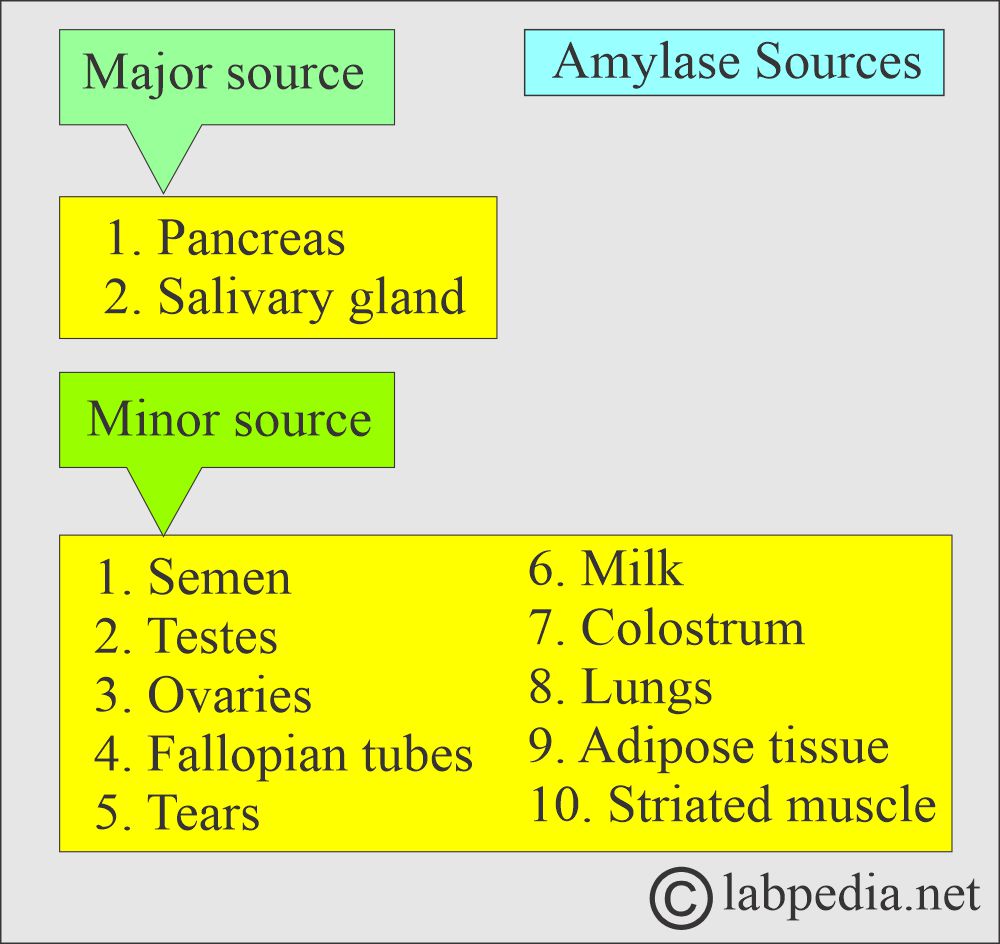
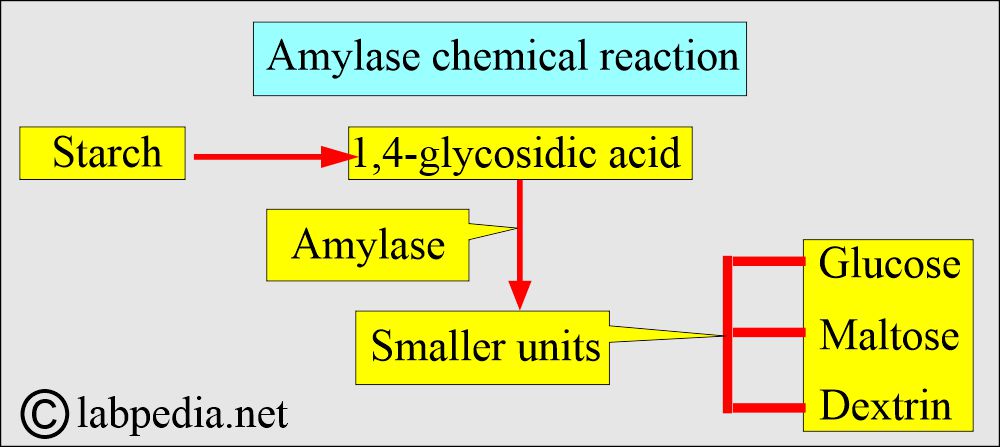


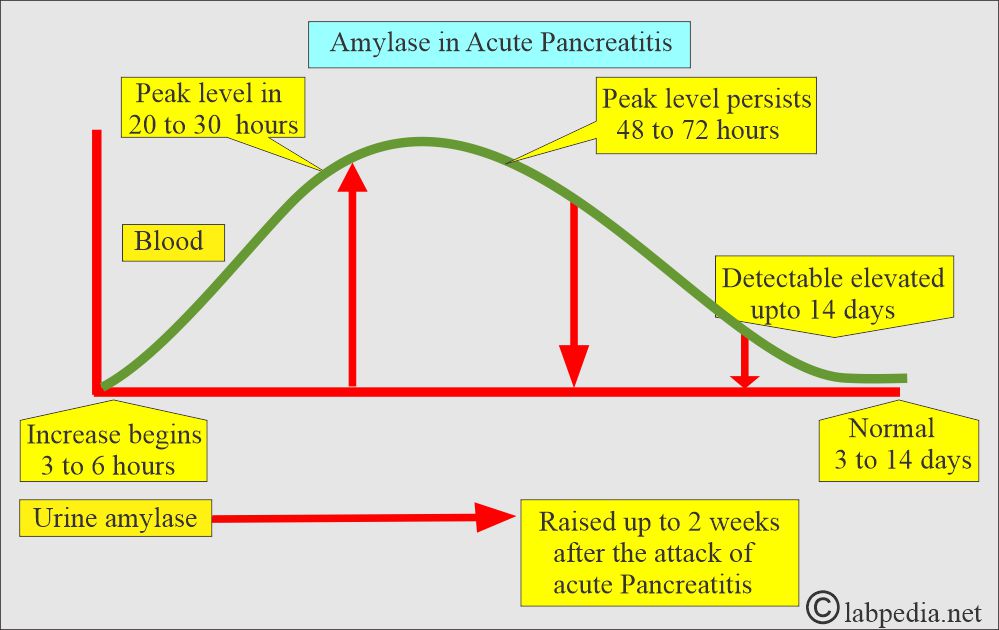
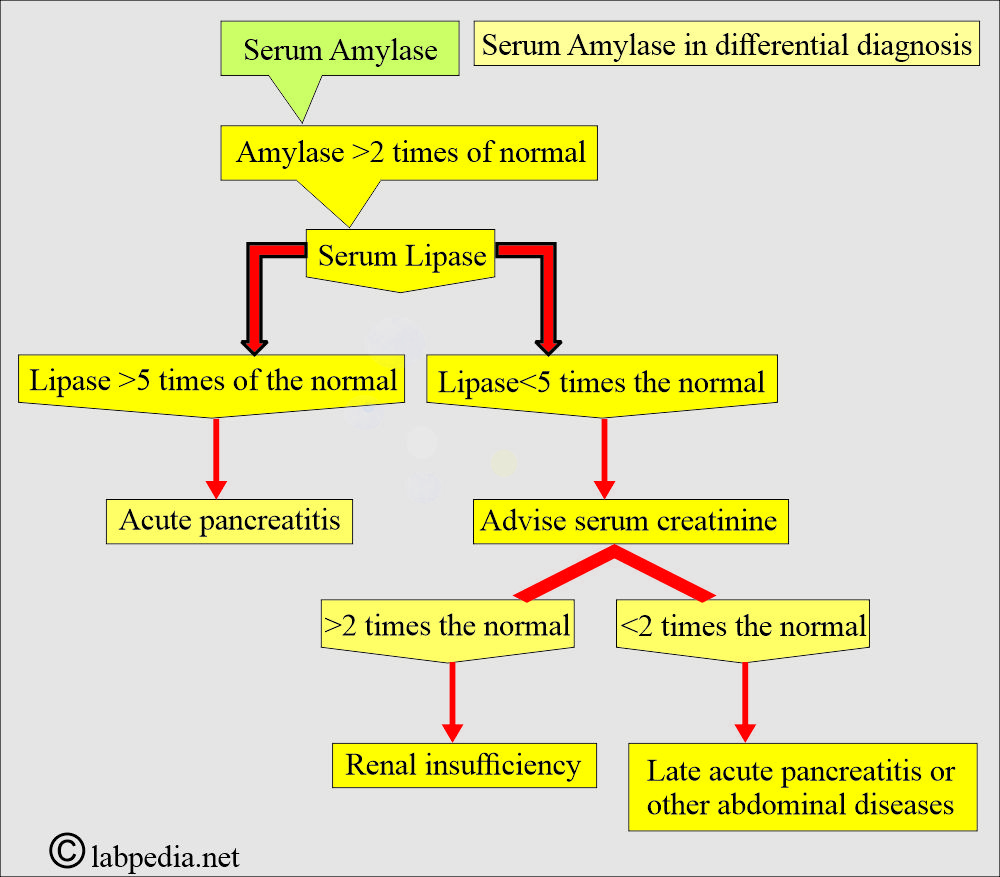
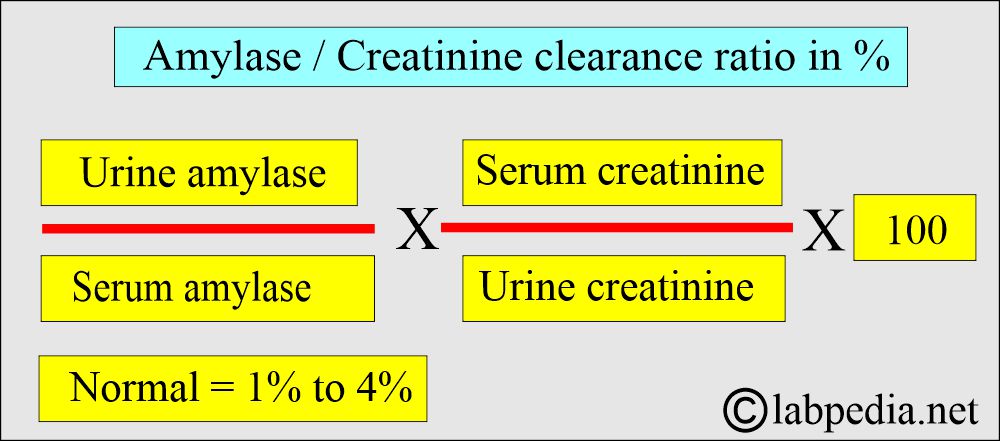
Bio chemistry
Clinal